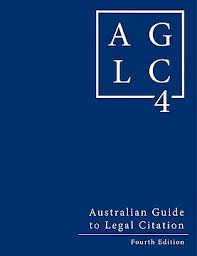
AGLC CITATION
The Australian Guide to Legal Citation (AGLC) is a citation style commonly used in Australian legal writing. It uses footnotes for referencing and requires a bibliography at the end of the document. It is detailed and structured to include specific information relevant to legal materials, such as cases, statutes, and secondary sources.
1. Footnote Citations
In AGLC, footnotes are numbered consecutively throughout the document. A footnote contains a full reference to the source, and subsequent citations of the same source can be shortened.
Format for Common Sources:
-
Books:
Author(s), Title (Edition, Publisher, Year) Page Number(s). -
Journal Articles:
Author(s), 'Title of Article' (Year) Volume(Issue) Journal Title Page Number. -
Cases:
Case Name (Year) Volume Law Report Series Starting Page, Pinpoint (Court). -
Legislation:
Name of Act Year (Jurisdiction) Pinpoint.
Examples for Different Sources:
Books:
First Footnote Citation:
- John Smith, The Evolution of Technology (2nd ed, HarperCollins, 2020) 45.
Subsequent Citation: 2. Smith, The Evolution of Technology, 50.
Journal Articles:
First Footnote Citation:
- Emily Brown, 'The Influence of Social Media on Mental Health' (2019) 12(3) Journal of Psychology 34.
Subsequent Citation: 2. Brown, 'The Influence of Social Media', 36.
Cases:
First Footnote Citation:
- Mabo v Queensland (No 2) (1992) 175 CLR 1, 15 (High Court).
Subsequent Citation: 2. Mabo (No 2) (1992) 175 CLR 1, 17.
Legislation:
First Footnote Citation:
- Environmental Protection Act 1994 (Qld) s 22.
Subsequent Citation: 2. Environmental Protection Act 1994 (Qld) s 25.
2. Subsequent Citations
After the first full citation, you can shorten subsequent citations by using only the author's last name and an abbreviated title or case name.
Examples:
-
Books:
Smith, The Evolution of Technology, 50. -
Journal Articles:
Brown, 'The Influence of Social Media', 36. -
Cases:
Mabo (No 2) (1992) 175 CLR 1, 17.
3. Ibid. for Repeated Citations
When a citation refers to the same source as the previous footnote, you can use "Ibid." If referring to the same page, just write "Ibid."; if it's a different page, write "Ibid." followed by the page number.
Examples:
- John Smith, The Evolution of Technology (2nd ed, HarperCollins, 2020) 45.
- Ibid., 47.
- Ibid.
4. Bibliography
The bibliography lists all sources cited in the footnotes and is organized by category (books, journal articles, cases, legislation, etc.). Within each category, sources are listed alphabetically by the author's last name or the first word of the title (for cases or legislation).
Format for Bibliography Entries:
-
Books:
Author(s), Title (Edition, Publisher, Year). -
Journal Articles:
Author(s), 'Title of Article' (Year) Volume(Issue) Journal Title Page Range. -
Cases:
Case Name (Year) Volume Law Report Series Starting Page. -
Legislation:
Name of Act Year (Jurisdiction).
Examples for Bibliography:
Books:
- Smith, John, The Evolution of Technology (2nd ed, HarperCollins, 2020).
Journal Articles:
- Brown, Emily, 'The Influence of Social Media on Mental Health' (2019) 12(3) Journal of Psychology 34–45.
Cases:
- Mabo v Queensland (No 2) (1992) 175 CLR 1.
Legislation:
- Environmental Protection Act 1994 (Qld).
5. Key Features of AGLC:
- Footnotes: Citations are placed in footnotes, allowing the text to remain uncluttered.
- Pinpoint References: For cases and legislation, pinpoint (specific page or section) references are required.
- Subsequent Citations: After the first full citation, subsequent footnotes can be shortened.
- Bibliography: A comprehensive bibliography is required, listing sources by category.
6. Special Cases in AGLC Citation
-
Multiple Authors: When there are two authors, include both names; for more than two, use "et al."
- Example: Smith et al., The Evolution of Technology.
-
No Author: If no author is available, begin the citation with the title of the work.
- Example: The Impact of Technology on Education (Tech Publishers, 2020) 45.
7. Why Use AGLC?
The AGLC is ideal for legal writing as it accommodates the precise citation needs of law cases, statutes, and other legal sources. It provides a clear and detailed approach to referencing, ensuring that legal documents are properly and rigorously cited, which is crucial for legal professionals and students. The use of footnotes helps maintain the flow of the text while providing comprehensive citation details at the bottom of the page.